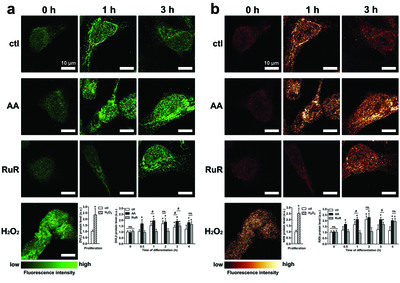Ascorbic acid alters cell fate commitment of human neural progenitors in a WNT/β-catenin/ROS signaling dependent manner

| Item Type: | Article |
|---|
| Title: | Ascorbic acid alters cell fate commitment of human neural progenitors in a WNT/β-catenin/ROS signaling dependent manner |
|---|
| Creators Name: | Rharass, T. and Lantow, M. and Gbankoto, A. and Weiss, D.G. and Panáková, D. and Lucas, S. |
|---|
| Abstract: | BACKGROUND: Improving the neuronal yield from in vitro cultivated neural progenitor cells (NPCs) is an essential challenge in transplantation therapy in neurological disorders. In this regard, Ascorbic acid (AA) is widely used to expand neurogenesis from NPCs in cultures although the mechanisms of its action remain unclear. Neurogenesis from NPCs is regulated by the redox-sensitive WNT/β-catenin signaling pathway. We therefore aimed to investigate how AA interacts with this pathway and potentiates neurogenesis. METHODS: Effects of 200 μM AA were compared with the pro-neurogenic reagent and WNT/β-catenin signaling agonist lithium chloride (LiCl), and molecules with antioxidant activities i.e. N-acetyl-L-cysteine (NAC) and ruthenium red (RuR), in differentiating neural progenitor ReNcell VM cells. Cells were supplemented with reagents for two periods of treatment: a full period encompassing the whole differentiation process versus an early short period that is restricted to the cell fate commitment stage. Intracellular redox balance and reactive oxygen species (ROS) metabolism were examined by flow cytometry using redox and ROS sensors. Confocal microscopy was performed to assess cell viability, neuronal yield, and levels of two proteins: Nucleoredoxin (NXN) and the WNT/β-catenin signaling component Dishevelled 2 (DVL2). TUBB3 and MYC gene responses were evaluated by quantitative real-time PCR. DVL2-NXN complex dissociation was measured by fluorescence resonance energy transfer (FRET). RESULTS: In contrast to NAC which predictably exhibited an antioxidant effect, AA treatment enhanced ROS metabolism with no cytotoxic induction. Both drugs altered ROS levels only at the early stage of the differentiation as no changes were held beyond the neuronal fate commitment stage. FRET studies showed that AA treatment accelerated the redox-dependent release of the initial pool of DVL2 from its sequestration by NXN, while RuR treatment hampered the dissociation of the two proteins. Accordingly, AA increased WNT/β-catenin signaling output i.e. MYC mRNA level, whereas RuR attenuated it. Moreover, AA improved neurogenesis as much as LiCl as both TUBB3-positive cell yield and TUBB3 mRNA level increased, while NAC or RuR attenuated neurogenesis. Markedly, the neurogenesis outputs between the short and the full treatment with either NAC or AA were found unchanged, supporting our model that neuronal yield is altered by events taking place at the early phase of differentiation. CONCLUSIONS: Our findings demonstrate that AA treatment elevates ROS metabolism in a non-lethal manner prior to the NPCs commitment to their neuronal fate. Such effect stimulates the redox-sensitive DVL2 activation and WNT/β-catenin signaling response that would enhance the ensuing neuronal cell differentiation. |
|---|
| Keywords: | Ascorbic Acid, Dishevelled, N-Acetyl-L-Cysteine, Neural Progenitors, Neuronal Differentiation, Nucleoredoxin, Reactive Oxygen Species, Redox State, WNT/β-Catenin Signaling |
|---|
| Source: | Journal of Biomedical Science |
|---|
| ISSN: | 1021-7770 |
|---|
| Publisher: | BioMed Central |
|---|
| Volume: | 24 |
|---|
| Number: | 1 |
|---|
| Page Range: | 78 |
|---|
| Date: | 16 October 2017 |
|---|
| Official Publication: | https://doi.org/10.1186/s12929-017-0385-1 |
|---|
| PubMed: | View item in PubMed |
|---|
Repository Staff Only: item control page
Downloads per month over past year
|
![[img]](http://edoc.mdc-berlin.de/16861/7.hassmallThumbnailVersion/16861suppl.jpg)




 Download Statistics
Download Statistics Download Statistics
Download Statistics
